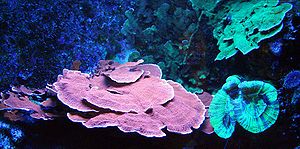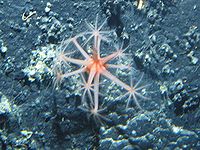Flower animals
| Flower animals | ||||||||||||
|---|---|---|---|---|---|---|---|---|---|---|---|---|

|
||||||||||||
| Systematics | ||||||||||||
|
||||||||||||
| Scientific name | ||||||||||||
| Anthozoa | ||||||||||||
| Ehrenberg , 1834 | ||||||||||||
| Subclasses | ||||||||||||
The flower animals (Anthozoa) are the largest class of the cnidarians (Cnidaria) with around 7500 species . Within this class there is no medusa form , that is, the animals only occur as polyps . This was previously interpreted as a reduction; today it is assumed that the medusa stage is primarily absent. They are therefore mostly the Medusozoa, i. H. contrasted with the other classes of cnidarians that form Medusa. The animals live solitary or colonial, as clones with or without a skeleton, which can be organic or mineralized. They live exclusively in the sea and occur there in all depths down to the abyssal depths. Most species, however, are restricted to the top 100 m.
features
The flower animals are characterized by the primary absence of the medusa stage . The trait is an original or plesiomorphic trait and cannot be used to justify monophyly . On the other hand , the polyps show three characteristics that only occur in polyps of the flower animals: actinopharynx, siphonoglyph and mesenteries .
The actinopharynx (also stomodeum) is an ectodermally lined tube that extends into the gastrovascular space (coelenteron, body cavity). It is present in all flower animals that have so far been examined in detail, with one exception, the black coral Sibopathes . The siphonoglyph (also sulcus) is a densely ciliated and mostly glandular region of the actinopharynx that occurs singly or in pairs. It is missing only in a few groups (e.g. ptyochodactiide sea anemones ). The presence of a siphonoglyph is also discussed among the antipatharia. The siphonoglyph characterizes the level of bilateral symmetry in the polyps. The third feature are the mesenteries, radially arranged leaf-shaped structures of the soft body, which extend from the body wall to the actinopharynx. The term septa should be reserved for the mineralized subdivisions of the gastrovascular space secreted by the mesenteries. The mesenteries, or at least some mesenteries, extend at least halfway between the body wall and the actinopharynx. They are arranged cyclically; Mesenteries of the same cycle are formed practically at the same time. The free tip of the mesentery is formed into a filament with gland cells, nematocysts and cilia ( mesenteric filament ). The cells forming the genital organs are contained in the mesenteric tissue and the epithelial muscle cells are concentrated. The arrangement of the mesenteries also shows evidence of bilateral symmetry.
habitat
Flower animals are bound to water and are found in all seas around the world. They can be found down to a depth of 6,000 m. Solitary specimens are bound to hard surfaces or buried deep in the mud or sand. Colony-forming flower animals encrust over other substrates or form skeletons of various shapes. Colonies of sea feathers (Pennatulacea) are anchored in the soft subsoil by the primary polyp. Reef-forming species typically live in shallow (up to 40 m deep), clear, tropical waters.
Development history
Molecular engineering studies classify the flower animals as the earliest branch of the cnidarians. The exclusive stage of life as a polyp , the primordial stage of all cnidarians, supports this order. The first fossils come from the Precambrian (about 540 million years ago). It was not until the Ordovician that fossils of mineralized flower animals became more common. The first fossils of hard corals (Scleractinia) are documented from the Triassic (about 230 million years ago).
Systematics
- Subclass Hexacorallia , also called six-pointed flower animals or zoantharia.
- The gastric space of these animals is divided from the stomach wall by paired, fleshy gastric ridges "mesenteries". In the recent Hexacorallia, six paired mesenteries (protomesenteries) are formed in the course of development, which extend from the base of the polyp to the pharynx. In the course of development, further pairs of mesenteries (metamesenteries) can be formed. The space between two mesenteries is called the gastric pocket. The number of tentacles corresponds to the number of gastric pockets (except for the Corallimorpha).
- Skeleton-bearing hexacorals have a basic skeleton, the calyx or polypar. In addition to the calyx wall, this consists of radial, vertical septa. The skeletal substance of the recent Hexacorallia is aragonite.
- Sea anemones (Actiniaria)
- Black corals (Antipatharia, also known as squirrel corals)
- Cylinder roses (Ceriantharia)
- Disc anemones (Corallimorpharia)
- Hard corals (Scleractinia)
- Crusty anemones (Zoanthidea)
- † Tabulata ("bottom corals")
- † Rugosa (also known as Tetracorallia)
- Subclass Octocorallia , also called eight-pointed flower animals or Alcyonaria.
- The gastric space of these animals is divided by eight unpaired mesenteries and they have a corresponding number of tentacles .
- With the exception of the Helioporida, the skeleton of the Octocorallia is derived from calcitic sclerites, which can grow together and thus form solid frameworks. They are formed by ectoderm cells that have migrated into the mesogloea. The Helioporida have no sclerites, their skeleton consists of aragonite fibers that are excreted by the basal ectoderm.
- Soft corals (Alcyonacea)
- Helioporacea
- Sea Feathers (Pennatulacea)
Phylogeny
According to the molecular genetic analysis by Collins (2002) and a combined morphological-molecular genetic analysis by Marques & Collins (2004), the flower animals are at the base of the cnidarians. They are the presumed sister taxon of all other classes of cnidarians. Cnidaria cladogram according to Collins (2002)
| Cnidaria |
|
||||||||||||||||||||||||||||||
|
|
See also
literature
- Isabel Koch, Franz Brümmer: Master Builder of the Reefs - Cnidaria ( Memento from September 28, 2007 in the Internet Archive ). Coral reefs - paradises under water - formation, ecology and threat. Part 2. in: Futura. Boehringer Ingelheim Fund, Stuttgart 1996.4. ISSN 0179-6372
- Marymegan Daly, Mercer R. Brugler, Paulyn Cartwright, Allen G. Collin, Michael N. Dawson, Daphne G. Fautin, Scott C. France, Catherine S. McFadden, Dennis M. Opresko, Estefania Rodriguez, Sandra L. Romano & Joel L. Stake: The phylum Cnidaria: A review of phylogenetic patterns and diversity 300 years after Linnaeus. Zootaxa, 1668: 127-182, Wellington 2007 ISSN 1175-5326 Abstract - PDF
- Allen G. Collins: Phylogeny of Medusozoa and the evolution of cnidarian life cycles . Journal of Evolutionary Biology, 15: 418-432, Oxford 2002.
- Antonio C. Marques and Allen G. Collins: Cladistic analysis of Medusozoa and cnidarian evolution. Invertebrate Biology, 123 (1): 23-42, Malden, Mass., 2004, doi : 10.1111 / j.1744-7410.2004.tb00139.x
Web links
- Daphne G. Fautin, Sandra L. Romano: Anthozoa - Tree of Life Project
- Hexacorallians of the World
- On the life of the corals ( Memento of March 17, 2005 in the Internet Archive ) (web archive)


